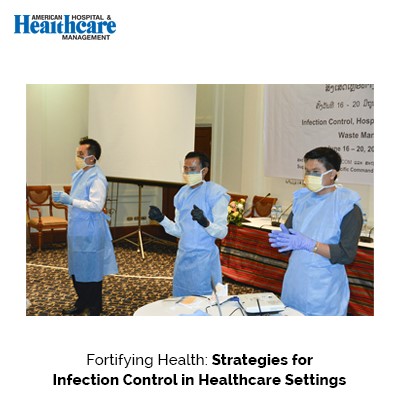In today's healthcare landscape, robust infection control strategies are crucial for patient safety. This article explores key approaches including hand hygiene, PPE usage, environmental cleaning, waste management, vaccination, and healthcare worker education, highlighting their importance in preventing healthcare-associated infections and improving overall patient outcomes.

In today's rapidly evolving healthcare landscape, infection control is more important than ever. As hospitals and healthcare facilities strive to provide safe and effective care, fortifying health through robust infection control strategies is essential. This article will explore the various approaches and best practices for infection control in healthcare settings.
The importance of infection control in healthcare settings
Healthcare-associated infections (HAIs) pose a significant threat to patient safety, prolong hospital stays, and increase healthcare costs. HAIs can be caused by a variety of microorganisms such as bacteria, viruses, and fungi. These infections can be acquired during the course of receiving medical care and can occur in any healthcare setting, including hospitals, nursing homes, and outpatient clinics.
Preventing HAIs requires a multidisciplinary approach that encompasses various strategies, including strict adherence to infection control practices. By implementing comprehensive infection control measures, healthcare facilities can minimize the risk of transmission and protect both patients and healthcare workers.
Common healthcare-associated infections
HAIs can manifest in different forms, with some being more prevalent than others. The most common types of HAIs include urinary tract infections (UTIs), surgical site infections (SSIs), bloodstream infections, and respiratory tract infections. These infections can have severe consequences for patients, leading to prolonged hospital stays, increased mortality rates, and added financial burdens.
Understanding the common types of HAIs is crucial for healthcare providers as it allows them to tailor their infection control efforts and prioritize preventive measures that target the specific pathogens responsible for these infections.
Strategies for preventing infections in healthcare settings
Hand hygiene: The foundation of infection control
Proper hand hygiene is the cornerstone of infection control in healthcare settings. Healthcare workers must perform hand hygiene before and after patient contact, after removing gloves, and before performing any invasive procedures. Hand hygiene can be achieved through handwashing with soap and water or by using an alcohol-based hand sanitizer when soap and water are not readily available.
Regular hand hygiene not only reduces the risk of transmitting pathogens from one patient to another but also protects healthcare workers from acquiring infections themselves. Healthcare facilities need to provide adequate hand hygiene resources, educate staff on proper hand hygiene techniques, and monitor compliance to ensure its effectiveness.
Personal protective equipment (PPE) in infection control
Personal protective equipment (PPE) plays a vital role in preventing the transmission of infectious diseases in healthcare settings. PPE includes gloves, masks, gowns, and eye protection. The appropriate use of PPE is essential, especially when dealing with patients who have known or suspected infectious diseases.
Healthcare workers must be trained on how to properly don, doff, and dispose of PPE to minimize the risk of contamination. Additionally, healthcare facilities should ensure an adequate supply of PPE and implement protocols for its appropriate use and disposal.
Environmental cleaning and disinfection in healthcare facilities
Maintaining a clean and hygienic environment is crucial for preventing the spread of infections in healthcare settings. Regular cleaning and disinfection of surfaces, medical equipment, and patient care areas can significantly reduce the risk of contamination.
Healthcare facilities should have robust cleaning and disinfection protocols in place, including the use of appropriate disinfectants and adherence to recommended contact times. Regular monitoring and auditing of cleaning practices can help identify areas for improvement and ensure compliance with infection control standards.
Proper waste management in healthcare settings
Effective waste management is an essential aspect of infection control. Healthcare facilities generate various types of waste, including biomedical waste, sharps waste, and general waste. Proper segregation, collection, and disposal of waste are critical to prevent the spread of infections and protect both healthcare workers and the environment.
Healthcare facilities should have clear guidelines for waste management, including color-coded bins, proper labeling, and staff education on waste segregation practices. Regular training and monitoring can help ensure compliance with waste management protocols.
Vaccination and immunization in infection control
Vaccination and immunization are powerful tools in preventing the spread of infectious diseases in healthcare settings. Healthcare workers should be up to date with their immunizations, including vaccines for influenza, hepatitis B, and other vaccine-preventable diseases.
Promoting vaccination among healthcare workers not only protects them from infections but also helps prevent the transmission of diseases to vulnerable patients. Healthcare facilities should have robust vaccination programs in place, including education and reminders for staff members to ensure high vaccination rates.
Education and training for healthcare workers
Education and training play a critical role in promoting adherence to infection control practices among healthcare workers. Regular training sessions should be conducted to educate staff on the importance of infection control, proper hand hygiene techniques, correct use of PPE, and other preventive measures.
Ongoing education can help reinforce infection control practices, address any knowledge gaps, and keep healthcare workers updated on the latest guidelines and best practices. Additionally, healthcare facilities should provide resources such as posters, brochures, and online modules to support continuous learning.
Infection control is a fundamental aspect of healthcare that cannot be overlooked. By implementing comprehensive infection control strategies, healthcare facilities can minimize the risk of healthcare-associated infections, protect patients and healthcare workers, and improve overall patient outcomes.
From practicing proper hand hygiene to ensuring appropriate use of PPE, healthcare providers must be diligent in their efforts to prevent the spread of infectious diseases. Education and training play a crucial role in promoting adherence to infection control practices, ensuring that healthcare workers stay up to date with the latest guidelines and best practices.
As the healthcare landscape continues to evolve, fortifying health through robust infection control measures remains a top priority. By prioritizing infection control, healthcare facilities can create safe environments for patients, staff, and visitors, ultimately contributing to better health outcomes for all.